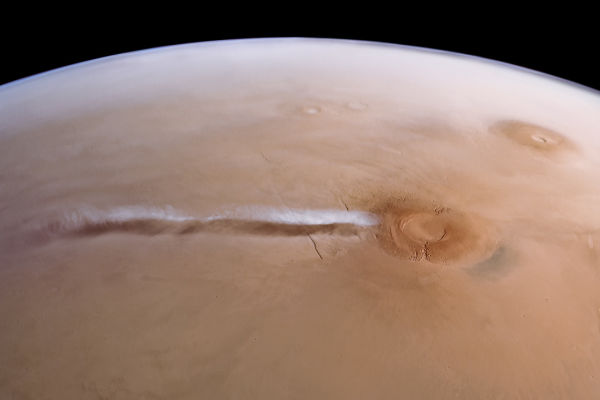A strangely shaped cloud extending up to 1,100 miles is believed to have formed from the Arsia Mons volcano on Mars.
In September 2018, the European Space Agency’s (ESA) Mars Express satellite detected a 1,500 kilometer long white cloud above the summit of Arsia Mons – a 20 kilometer high volcano near the equator . March. The appearance of this mysterious cloud confused many scientists at that time.
Some websites even claim that the cloud may have been smoke emitted by volcanic activity, suggesting Arsia Mons may have erupted. However, this information was later refuted, as Mars has not had a volcanic eruption for millions of years.
Since then, scientists have focused on decoding this mysterious band of clouds called AMEC (Arsia Mons Long Cloud). Thanks to the camera equipped with the Mars Express satellite, scientists finally have a better view of how the cloud forms and disappears.
Basically, there are many difficulties in studying the formation of AMEC, as this cloud usually dissipates very quickly, while ships orbiting Mars cannot follow it around the clock.
AMEC appeared in the spring of March, with a maximum attainable length of 1,800 km. It is formed by the hot and humid air moving up the side of the mountain. The atmosphere of Mars is extremely thin, and liquid water barely exists on its surface. Even so, there is enough moisture in the air to allow thin clouds to form.
“This is the largest mountain peak cloud ever seen on Mars. It forms when winds are pushed high by topographic features (such as mountains or volcanoes) on the surface of Mars,” the European space agency.
AMEC comes and goes every day, for 80 days or more. It begins to form before sunrise and grows rapidly in about 2.5 hours. The cloud then extends beyond the summit of Arsia Mons at an extended speed of up to 600 km / h at an altitude of 45 km. It eventually evaporated when the daily temperature on Mars warmed as the sun rose.
On Earth, similar cloud peaks appear, but they are still “far” in degrees from the AMEC cloud on Mars.
Although observations from Mars Express reveal the daily cycle of AMEC, at least one big question remains about this meteorological morphology.
According to ESA, clouds have formed over all volcanoes almost throughout the Martian year. However, all of these clouds disappear during the Martian spring – with the exception of the Arsia Mons cloud. This is the time AMEC came and repeated, day in and day out. Why does AMEC only appear at the top of Arsia Mons and not on the other volcanoes on Mars? This is a problem that scientists will have to address in the future.



